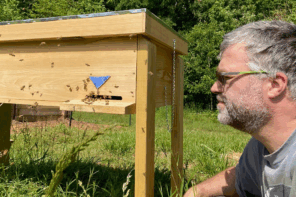Click Here if you listened. We’d love to know what you think. There is even a spot for feedback!
Read along below!
 The Quiet, Quick Life of the Honey Bee Egg
The Quiet, Quick Life of the Honey Bee Egg
The critical, but unassuming development stage
By: James E. Tew
The quiet beginning
The beginning stage of a honey bee’s life is the smallest and quietest of any of the four developmental stages – egg, larva, pupa and adult. In fact, many beekeepers have problems even seeing eggs at all, but that’s not a criticism. Even the best of eyes can have problems seeing a tiny white egg (looking like a miniature grain of rice) standing on end in a cell of snow-white comb. Eggs are not much longer than a typewritten dash (“-”) (<1/16 inch) and weighs nearly nothing (0.12-.22mg) which means an egg probably doesn’t weigh much more than a typewritten dash either. Yet the presence or absence of eggs and their quantity, are good measurements of activities going on inside the hive.
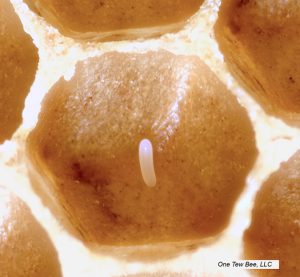
Figure 1. A fertile egg, the first stage of a female honey bee.
Getting a look at eggs under field conditions
Firstly, you need to get your mind right and your glasses adjusted. Think small. With either dark or light comb, hold the comb at a 30-40 degree angle before you. You decide the viewing distance. Have the sunlight coming over one of your shoulders. Using the top bar as a pivot line, raise and lower the bottom bar about three to five inches—all the while scrutinizing randomly selected cell bottoms. Let your eyes scan the comb bottoms. Eggs tend to be laid in patches of cells. Once you find one egg, you can probably begin to see them all around in surrounding cells. I think eggs are equally difficult to see in either color cell (light or dark). In dark cells, the polished cell bottom can glisten and look much like an egg. Alternatively, the light cell bottoms of new comb cells can camouflage the small white egg. Take heart, what seems impossible at first does get much easier as your train your eye.
A cautionary note – many years ago, a prominent researcher told me that UV light from bright sunlight will quickly sunburn delicate, tiny larvae. If held in the hot Summer sun too long, I would suppose that eggs could be damaged, too.
When using sunlight for viewing, he suggested that I move as quickly as possible. He also said that I should not use bright sunlight to graft larvae when raising queens. I have only heard this one time – from him – but it sounds logical. (He’s no longer here so I can’t ask for a review.)
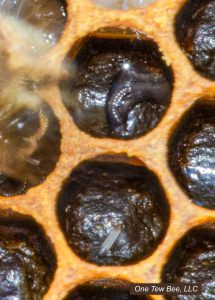
Figure 2. An egg (lower cell) compared to a 1st instar larva. (Upper cell) The egg and larvae are approximately the same size.
A useful tool
Naturally, look for eggs in logical places within the brood nest. The center of the brood nest (normally the center of the hive) is the best place to look for eggs. But suppose you are trying to decide how well a queen is performing or what kind of a future population of bees you will have within the next few weeks. To determine that estimate, you need more than just seeing eggs in the center comb. Work from the center outward, toward both sides of the colony. Be careful not to damage your queen. Under the crowded conditions of a late Spring colony, there is a risk of rolling the queen off the comb if you remove a center comb first. How far out on either side did you see eggs or brood? If it’s early Spring and you’re finding capped brood and eggs on the center three frames and then eggs on the next two frames (three to six frames of brood), you should have a colony that will build up on a normal build-up schedule. Anything more, and you are probably going to have a boomer colony while anything less may indicate a failing queen, bad weather or low honey and pollen stores.
Most beekeepers will accept seeing eggs as a substitute for seeing the queen during a quick inspection. Finding eggs means that you had a queen in that colony at least three days ago. It’s not a conclusive analysis, but it is quick and will satisfy most inspection needs.
What if you found no eggs or brood at all?
Under some conditions panic is in order while in other situations, seeing no eggs at all is normal. In climates having a cold Winter, egg/brood production will completely stop during the coldest part of the season. If you’re inspecting a colony during a warm day in that period, expect no eggs, ergo no brood. But you can assume there is a queen in place in the colony. Unless you happen to see her, you have no other choice but to assume she’s there. However, if Winter is waning and Spring is on the way and you are not finding eggs along with older stages of brood, a failing queen would be suspected. Any time after mid-Winter in most areas, a colony should have varying amounts of brood in all stages.
What if you are finding larvae and capped brood, but no eggs?
The larval stage lasts about 5.5 days. You can forensically decide if you accidentally killed the queen the last time you were in the colony. Since larvae are present, your colony had a queen about five to six days ago. Were you in the colony during those days?
If the time of the year is right (anything warm), consider either swarming or supersedure as being the reason. If all stages are present except eggs and you have ruled yourself out, the colony could have swarmed or could be replacing its queen. Swarm cells are generally on the bottom edges of the frame (but not always) while supersedure cells are on the “face” of a brood frame (but not always).
Time spent waiting for the new queen to show herself is a difficult period for many beekeepers. Maybe it’s like a surgeon saying, “We won’t know how well the surgery went until the patient awakens.” So how do you tell if the queen has shown herself? Look for eggs as described previously. Once you see them, get out of the colony. The queen is not in conclusive control of the colony until she has her own open brood present.
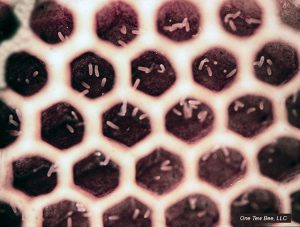
Figure 3. Too many eggs are not a good sign. This colony is finished.
What if you’re finding entirely too many eggs – in fact, multiple eggs per cell?
It could be laying workers. This is not good news. Worker bees can’t mate nor store sperm. They’re also missing genital structures and some behavior patterns. In essence, an adult worker bee cannot become a true queen.
Since laying workers cannot fertilize eggs, any eggs produced will become drones. Fertilized eggs (32 chromosomes) become either queens or workers, while unfertilized eggs (16 chromosomes) only become drones (males). It’s well known that males (drones) primarily contribute reproductive activities with unmated queens. Laying worker colonies produce entirely too many drones and are unable to maintain routine nest activities.
After a colony becomes hopelessly queenless, laying workers will generally develop within 23-30 days or so. Colonies may have one too many laying workers. A major indication of the presence of laying workers is multiple eggs within single cells – all of which will ultimately become drones.
By the time the colony has dealt, unsuccessfully, with its queenless situation (about 30 days), it will have become noisy (excessive orientation fanning when the colony is opened), nervous and possibly a bit aggressive. The colony will be weak and its hive members old. It’s probably not worth saving – but it will have eggs all over the brood nest area. In this case, abundant eggs per cell are not a good indicator.
But not always
There are other times when a colony with a perfectly good queen can have multiple eggs within single cells. If, at any time, the beekeeper introduces a strong, productive queen into a small, but biologically balanced colony, the queen’s egg output may exceed the smaller colony’s ability to provide cellular space for all her eggs. In that case, it is common for a queen to place two to several eggs per cell. But, in this case, all eggs are fertile and the colony is in no danger of collapse. In this case, abundant eggs per cell are good (or at least okay) until colony dynamics are stabilized.
What happens to extra eggs within single cells? They are probably eaten by nurse bees, though not necessarily quickly. It may take several hours even to a couple of days for nurse bees to remove either dead or misplaced eggs. In fact, when grafting larvae for queen production, I’ve frequently seen two eggs, and later two larvae, occupying the same cell. I’ve wondered, given the tremendous growth rate of larvae, if occasionally one larva eats the other or is it always the nurse bees that remove the extra larvae? Do larvae even have the mouthparts needed to eat another larva? I don’t know.
Some egg biology and behavior
The egg is a hardy developmental stage of the bee’s growth. It is attached with a secreted glue-like substance by its small end. It’s iridescent white with a gentle bend. The egg is positioned with the head-end up. After about three days, the egg gradually leans over until it lays on its side on the cell base. The egg’s outer membranous covering (the chorion) slowly dissolves as the larva emerges. It’s a slow, quiet process. Nurse bees soon begin to place hypopharyngeal gland secretions (brood food) around and under the larva which has a voracious appetite.
Beekeepers frequently say that an egg hatches when referring to a larva emerging. As such, the bee egg does not “hatch” though the word transfers the concept. However, due to the membrane dissolution, don’t ever expect to see tiny bee-egg shells drop from cells containing new larvae.
Though the egg normally develops within three days, it’s reported development range is two to six days. Temperature appears to play a role in the duration of the egg’s development. Eggs can commonly withstand room temperature for several hours without the ill effects shown by larvae and pupae held under the same conditions.
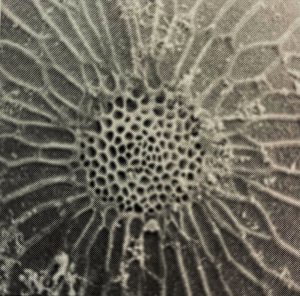
Figure 4. The micropyle, where sperm enters the honey bee egg, on the upper end of the egg (x600)1
Haploid (drone) verses diploid (female) eggs.
The egg is filled with cytoplasm, a nucleus and a yolk. The nucleus is near the big end of the egg and plays a major role in the development of a future bee. A newly fertilized honey bee queen will have nearly seven million sperm stored in a special pouch that is named the spermatheca. Sperm is stored there, apparently in somewhat of a suspended animated state, for several years. Adult female worker bees can’t do all this, hence a major difference between the anatomy and physiology of workers and queens.
The adult, fertile queen has a muscular valve and pump which are used to withdraw a small amount of sperm from the spermatheca, pump it down the duct to an opening in the vagina where a vaginal valve fold forces the egg’s micropyle (an opening in the larger end of the egg) against the opening of the vaginal sperm duct. The connection made, one or more sperm is passed into the egg. The newly fertilized egg becomes diploid (a full chromosomal content) and develops into a female (a worker or a queen).
Shut down the entire sperm-releasing mechanism and the egg remains sperm-free, resulting in a haploid egg (one half of the chromosomal number). The unfertilized egg becomes a drone. A queen can seemingly tell a worker cell from a drone cell by measuring the cell diameter with her front legs and will deposit the appropriate egg. However, mistakes are occasionally made. Nurse bees, ever alert to errors, clean up the mistake by eating the errant egg.
The egg output of a good queen
This simple question is still not answered conclusively, though many respectable estimates have been made. The most accepted estimate is 3,000 eggs per day during the height of the egg-producing season. This is about twice the weight of the queen and is about 1,500,000 eggs for her entire career (a little less than three years). This estimate is dependent on many factors – temperature, food availability (including pollen) and inherited characteristics.
Being a queen is a harsh job
Ironically, our perspective of the queen as a regal monarch is probably not a sound one. The queen literally has food stuffed in one end while eggs are pushed from her other end – probably about one egg per minute. That’s not exactly a leisure life. Nurse bees can control the egg flow by controlling the food input. Slow the food input and the egg rate drops. (Why do I have a nagging feeling that I’m simplifying this description too much?) Other house bees are responsible for preparing cells for receiving eggs. Incoming nectar and pollen may also affect the egg flow by directly affecting the nurse bees that care for the developing brood.
So, the queen systematically (if she is a good one by our beekeeper standards) searches for prepared cells. Upon finding one, she puts the appropriate egg (drone or female) egg in the appropriate-sized cell. If she’s not fed well or if clean and polished cells are not ready, she decreases egg laying proportionally. But apparently, it was not her decision to do so. If the queen can’t produce enough eggs when pushed to do so, she will be superseded by the same nurse bees. There’s not much of a retirement plan for queen bees.
Eggs are small, but they are critical
There’s no cause to make honey bee eggs any more or less important than they should be. However, due to their small size and their quiet existence, I don’t know if they always get their due regards. Even in this article, I skimmed over the amazing biological complexity and changes that occur within eggs after fertilization. However, eggs give me useful information concerning the presence (or absence) of a queen, an indication of her performance, the overall health of the colony and an estimate of the colony’s immediate future. Even though they are small, they can tell you a lot – if you can see them.
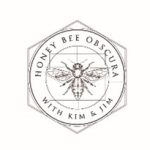
Dr. James E. Tew
Emeritus Faculty, Entomology
The Ohio State University
tewbee2@gmail.com
Host, Honey Bee Obscura Podcast
www.honeybeeobscura.com
Bibliography
Dade, H.A. 1977. Anatomy and Dissection of the Honey Bee. International Bee Research Association. London England. 158pp
Eckert, John E. & Shaw, Frank R. 1960, Beekeeping. Macmillan Publishing Co., Inc. New York. 536 pp.
Nelson, James Allen. 1915. The Embryology of the Honey Bee. Princeton University Press. Princeton. 282pp.
Ribbands, C.R. 1953. The Behavior and Social Life of Honey Bees. Dover Publications. New York. 352 pp.
Stell, Ian. 2012. Understanding Bee Anatomy: a full colour guide. The Catford Press. 200pp.
Winston, Mark L. 1987. The Biology of the Honey Bee. Harvard University Press. Cambridge, MA. 281 pp.








